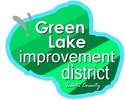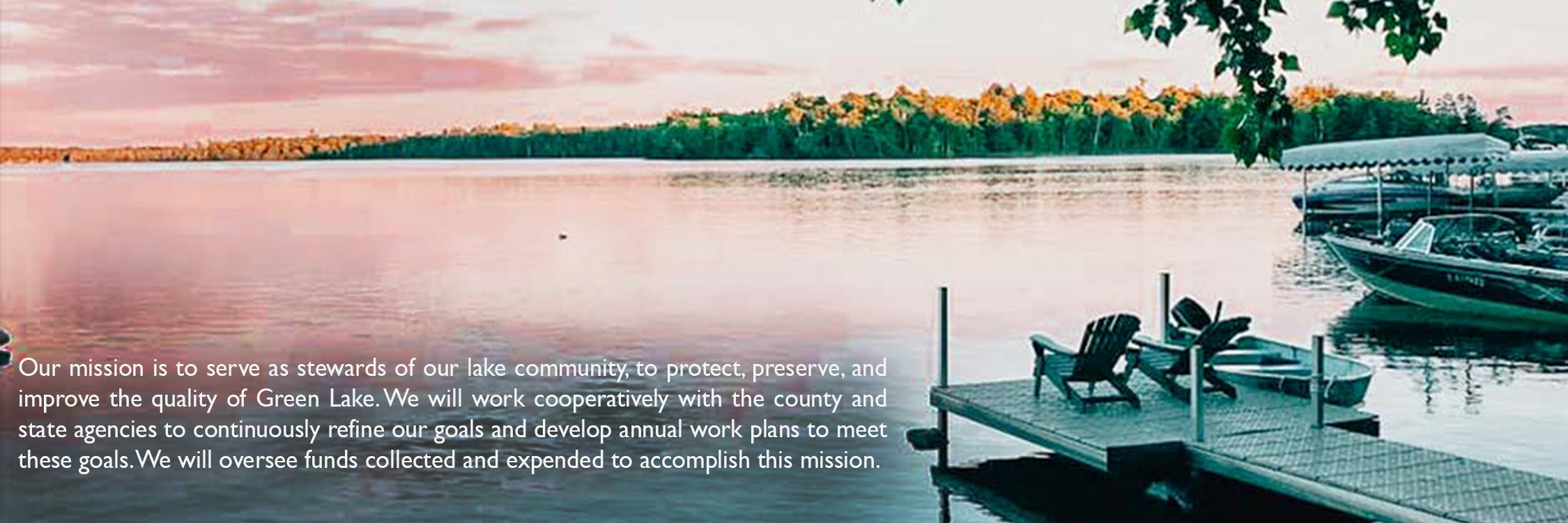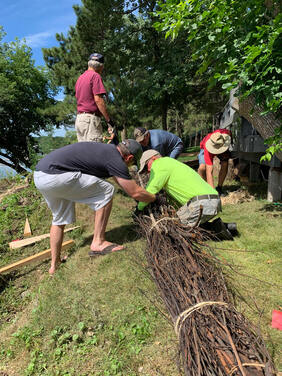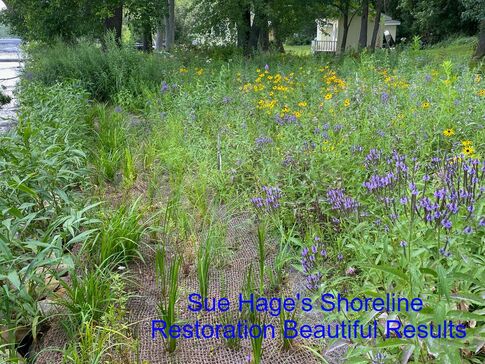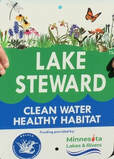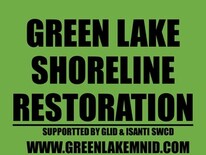Shoreline Restoration Info
Plus "Are You a Lake Steward?" 13 Question Survey
to see if your shore could use a lake restoration activity.
Accepting Green Lake Lakeshore Restorations Interest Forms Now

Green Lake Shoreline Restorations continue to be a nutrient reduction focus area.
If you have any concerns about natural resources on your property or if you would like talk about ways a person can improve lake water, you are just a call (763-689-3271) away from help!
Green Lake Improvement District and Isanti Soil and Water has funding available to help Green Lake property owners having erosion concerns helping with shoreline restorations with 25% help and/or construct rain gardens with 75% help
2023 SWCD's Green Lake Watergarden Promotion with 75 Percent Funding!
What can I do to keep my shoreline from washing away? INFO FROM DNR hotlink
Learn about one alternative of Shoreline stabilized with riprap and enhanced with a vegetative buffer.
-Vegetated buffers, deeply rooted plants, shrubs, and trees remove nitrogen and phosphorus before it enters the lake.
Why is riprap used at times with vegetated buffer like long grass, deeply rooted plants?
-Wind beaten shores sometimes offer no other solutions and proven erosion issues do allow shore protection when rip rap is constructed per MN DNR guidelines at a 3:1 slope. Generally east, south east, and northeast sides of lakes.
GLID is offering to help Green Lake landowners restore eroding or non-buffered shorelines.
GLID has limited restoration assistance funds of 25% of Project ($1000 max ) along with additional Volunteer credits (max $500) for pre-approved paid projects or construct rain gardens with 75% help!
Step by step approach:
1- Fill out the " I Am Interested Form" For more help with starting your shoreline restoration or rain Garden to halt erosion, please contact
Call SWCD to get started with Todd Kulaf Office: 763-689-3271 Cell: 715-370-3838
Email: tkulaf@IsantiSWCD.orgat 763-689-3271.
GLID's Del Smith Phone: 952-201-9615 email: delvacinst@gmail.com OR
GLID's Sue Hage Phone 612-296-2529 email: suehage@aol.com
2- Sign Contract with lake shoreline consultant company to get pre-approved plans in place, satisfy DNR and Isanti Count Zoning
3- When project is completed, contract payments are completed in full, Request reimbursement from Green Lake Improvement District
What, exactly, constitutes a “shoreline restoration” project? What does it do and what should it look like? A “shoreline restoration” project should effectively stop (or at least greatly reduce) storm runoff. A 15-25 foot deep buffer at the shoreline that is strategically placed to stop runoff and stabilize the bank against erosion from wave action is a start.
Click here for an excellent informational SWCD Video called "Our Lakeshore Connection"
QUICK READ>>> 10 Tips to Lake Stewardship
Are You a Lake Steward? Does your shoreline protect water quality? Take the quiz and find out with 13 Questions
Take the “Are You a Lake Steward Quiz” to see how well you are protecting Minnesota’s lakes from your own backyard – and steps you can take to improving your impact on the environment. Brought to you by Minnesota Lakes and Rivers.
Here is a DO-IT-YOURSELF DNR's "SCORE YOUR SHORE " hotlink here to see if your shoreline needs restoration help complete with TIPS and recommended CRITERIA to measure against.
Want even MORE details, look at the DNR's Shoreline Restoration Reference Manual here
-------
Sue Hage and Family Receive 2022 Lake Steward Award!
From Sue "Thank you so very much for the kind words and for this awesome recognition!! It has been a learning process over the past six years of working on restoring the Green Lake shoreline but we have successfully found solutions that work (on our round, water-level fluctuating lake)!We look forward to displaying the sign amongst the beautiful density of flowers and plants along the shore. When you anchor the shore and plant the right plants, it’s amazing what nature does! We are amazed by the millions of native (desirable) plants that have filled in and all the bees and butterflies that flock there! We are grateful that we got on board with the Lakeshore Restoration project that initially started in 2016. We have learned so much and we have been able to work side-by-side with GLID, Isanti SWCD, the DNR and neighbors who all care so much about protecting our lakes/rivers and resources."
Understanding Ordinary High Water Level - Important info for Shoreline Restorations hotlink
Did you know the Green Lake Sub-Watershed Retrofit Analysis reported 95 lakeshore sites that were candidates? Per the report, if all 95 were completed, the total Phosphorus flow into Green Lake from those areas would be reduced by 44%.
Did you know that just ONE non-buffered lakeshore's nutrient runoff could produce up to 80 pounds of algae!!!.... including the toxic Blue-Green Algae.
Green Lake Shoreline Restoration Projects History
Click on the Owner's names hotlinks to have a glimpse of the before and after pictures.
ALL the Green Lake Owners below earned and received Green Lake Restoration Award Sign
Check out the Dan Howard's 2020 Green Lake Restoration Summary here!
Green Lake Owners that Completed Shoreline Restoration with Dan Howard
> Leider, Bullock, Plates, Adam Anderson, Oliver, Mortenson, Gwen Peterson, O'Donnell, Leach, Hage, Dancik, Braun, Sargent, Del Smith, Reinke/Solomonson
Green Lake Owners that Completed Shoreline Restoration 2016-2017
> Carlson, Chilson, Dancik, Glenn, Hage, Lind, Orton, Roos.
CLICK HERE for a 2016-2017 summary, including details with before and after pictures of the projects.
SIMPLE STEPS TOWARD BETTER LAKE STEWARDSHIP
These are DNR simple steps lake property owners can take to become better shore land stewards.
1. Protect existing native trees, shrubs, and plants.
2. Stop fertilizing and using lawn chemicals. If you water your lawn with water pumped from the lake, use of chemical fertilizer is unnecessary because the lake water already contains nitrogen and phosphorus. If you feel you must fertilize, do so once a year, in the fall.
3. We highly recommend no broadcast spraying of insecticides and pesticides. Please be kind to pollinators.
4. “No mow, let it grow!” This is the simplest and least expensive way to restore shoreline and add a natural buffer to the lakeshore. First, stop mowing a 10 - 15ft wide strip of grass near the water’s edge. If you have a beach, the buffer can be directly behind the beach. A buffer of native vegetation will help prevent erosion and will intercept some of the nutrients and pollutants that would otherwise enter the lake.
5. If you don’t like the look of an un-mowed buffer, you can plant a buffer of native wildflowers and sedges. Bushes or trees can also be added.
Checkout your GLID Shoreline Restoration Program with grants for approved projects. A buffer of native plants will add color and beauty to your shoreline and provide food and habitat for birds, butterflies, and other pollinators.
6. If you riprap or place boulders on the shoreline, do not spray with herbicides as toxins go into lake. If you let nature take its course, native plants such as jewel weed, milk weed, and blue flag iris may naturally germinate, or you can plant them within the riprap.
7. Have your septic system tested and keep it working properly. Faulty septic’s account for lake pollution.
Great 45 minute webinar can be found at: septic.umn.edu/sites/septic.umn.edu/file s/drinking_water_final.mp4
Benefits of Native Aquatic Plants Workshop Recorded and Available to You!
https://youtu.be/FpJf77msUEk << hotlink
The speaker Dr. Ray Newman, a professor from the University of Minnesota. The talk will include topics such as how plants contribute to a lake's nutrient cycle, how native plants alter a lake, and management options. There will be time for questions and answers at the end. The workshop is open.
Green Lakers at the Benefits of Native Aquatic Plants workshop. We did record it, there was some really good information provided by Ray Newman (professor at U of M).
Green Lake Shoreline Maintenance Workshop -Sept 16th!- COMPLETED!
The Shoreline Maint workshop was informative!
It took place at Hage's amazing 2016 shoreline restoration project on Green Lake.
This was an in-person event to teach how to do regular maintenance on shoreline buffers. Topics will include how to identify weeds from native plants, how best to remove weeds, how to split thriving plants and more!
Aaron Soltau from the Prairie Restorations Inc and Todd Kulaf from SWCD shared their vast knowledge , provided recommendations, and answered all the questions the active participants asked! A SUCCESS!
SWCD sponsored the event, Here is hotlink to Lydia's notes
If you have any concerns about natural resources on your property or if you would like talk about ways a person can improve lake water, you are just a call (763-689-3271) away from help!
Green Lake Improvement District and Isanti Soil and Water has funding available to help Green Lake property owners having erosion concerns helping with shoreline restorations with 25% help and/or construct rain gardens with 75% help
2023 SWCD's Green Lake Watergarden Promotion with 75 Percent Funding!
What can I do to keep my shoreline from washing away? INFO FROM DNR hotlink
Learn about one alternative of Shoreline stabilized with riprap and enhanced with a vegetative buffer.
-Vegetated buffers, deeply rooted plants, shrubs, and trees remove nitrogen and phosphorus before it enters the lake.
Why is riprap used at times with vegetated buffer like long grass, deeply rooted plants?
-Wind beaten shores sometimes offer no other solutions and proven erosion issues do allow shore protection when rip rap is constructed per MN DNR guidelines at a 3:1 slope. Generally east, south east, and northeast sides of lakes.
GLID is offering to help Green Lake landowners restore eroding or non-buffered shorelines.
GLID has limited restoration assistance funds of 25% of Project ($1000 max ) along with additional Volunteer credits (max $500) for pre-approved paid projects or construct rain gardens with 75% help!
Step by step approach:
1- Fill out the " I Am Interested Form" For more help with starting your shoreline restoration or rain Garden to halt erosion, please contact
Call SWCD to get started with Todd Kulaf Office: 763-689-3271 Cell: 715-370-3838
Email: tkulaf@IsantiSWCD.orgat 763-689-3271.
GLID's Del Smith Phone: 952-201-9615 email: delvacinst@gmail.com OR
GLID's Sue Hage Phone 612-296-2529 email: suehage@aol.com
2- Sign Contract with lake shoreline consultant company to get pre-approved plans in place, satisfy DNR and Isanti Count Zoning
3- When project is completed, contract payments are completed in full, Request reimbursement from Green Lake Improvement District
What, exactly, constitutes a “shoreline restoration” project? What does it do and what should it look like? A “shoreline restoration” project should effectively stop (or at least greatly reduce) storm runoff. A 15-25 foot deep buffer at the shoreline that is strategically placed to stop runoff and stabilize the bank against erosion from wave action is a start.
Click here for an excellent informational SWCD Video called "Our Lakeshore Connection"
QUICK READ>>> 10 Tips to Lake Stewardship
Are You a Lake Steward? Does your shoreline protect water quality? Take the quiz and find out with 13 Questions
Take the “Are You a Lake Steward Quiz” to see how well you are protecting Minnesota’s lakes from your own backyard – and steps you can take to improving your impact on the environment. Brought to you by Minnesota Lakes and Rivers.
Here is a DO-IT-YOURSELF DNR's "SCORE YOUR SHORE " hotlink here to see if your shoreline needs restoration help complete with TIPS and recommended CRITERIA to measure against.
Want even MORE details, look at the DNR's Shoreline Restoration Reference Manual here
-------
Sue Hage and Family Receive 2022 Lake Steward Award!
From Sue "Thank you so very much for the kind words and for this awesome recognition!! It has been a learning process over the past six years of working on restoring the Green Lake shoreline but we have successfully found solutions that work (on our round, water-level fluctuating lake)!We look forward to displaying the sign amongst the beautiful density of flowers and plants along the shore. When you anchor the shore and plant the right plants, it’s amazing what nature does! We are amazed by the millions of native (desirable) plants that have filled in and all the bees and butterflies that flock there! We are grateful that we got on board with the Lakeshore Restoration project that initially started in 2016. We have learned so much and we have been able to work side-by-side with GLID, Isanti SWCD, the DNR and neighbors who all care so much about protecting our lakes/rivers and resources."
Understanding Ordinary High Water Level - Important info for Shoreline Restorations hotlink
Did you know the Green Lake Sub-Watershed Retrofit Analysis reported 95 lakeshore sites that were candidates? Per the report, if all 95 were completed, the total Phosphorus flow into Green Lake from those areas would be reduced by 44%.
Did you know that just ONE non-buffered lakeshore's nutrient runoff could produce up to 80 pounds of algae!!!.... including the toxic Blue-Green Algae.
Green Lake Shoreline Restoration Projects History
Click on the Owner's names hotlinks to have a glimpse of the before and after pictures.
ALL the Green Lake Owners below earned and received Green Lake Restoration Award Sign
- Leach Project @ 6940 338TH LN NW, 100 linear ft
- P Mortenson Project @ 6940 338TH LN NW, 103 linear ft
- Glenn Project @ 7201 330TH LN NW: 142 linear ft
- Dancik Project @ 7112 337TH LN NW, 114 linear ft
- Sargent Project @ 32998 NACRE ST NW 150 linear ft
- Thovson Project @ 33512 XENON DR NW 87 linear ft
- Del Smith Project 100 linear ft
- Orton Project : 122 linear f
- Hage Project 137 linear ft
- Reinke Project 130 linear ft
- Burdock Project 120 linear ft
- Lind Project: 98 linear ft
- Hammer Project:150 ft
- Chilson Project: 60 ft
- Roos Project: 88 linear ft
- A Anderson Project 95 linear ft
- Oliver Project 82 linear ft
- Gwen Peterson Project 100 linear ft
- Leider Project 2019 93 linear ft
- Harten shoreline restoration 2022 project 37 linear ft
- Howland Shoreline Hillside Restoration 2022/23 with Shoreline pending project
- Portz Shoreline Hillside Restoration 2022/23 with Shoreline pending project
- McElrath Shoreline Restoration 2022/23
- McElrath Hillside Rain Garden 2023
- Hocamp shoreline stabilization 2023
Check out the Dan Howard's 2020 Green Lake Restoration Summary here!
Green Lake Owners that Completed Shoreline Restoration with Dan Howard
> Leider, Bullock, Plates, Adam Anderson, Oliver, Mortenson, Gwen Peterson, O'Donnell, Leach, Hage, Dancik, Braun, Sargent, Del Smith, Reinke/Solomonson
Green Lake Owners that Completed Shoreline Restoration 2016-2017
> Carlson, Chilson, Dancik, Glenn, Hage, Lind, Orton, Roos.
CLICK HERE for a 2016-2017 summary, including details with before and after pictures of the projects.
SIMPLE STEPS TOWARD BETTER LAKE STEWARDSHIP
These are DNR simple steps lake property owners can take to become better shore land stewards.
1. Protect existing native trees, shrubs, and plants.
2. Stop fertilizing and using lawn chemicals. If you water your lawn with water pumped from the lake, use of chemical fertilizer is unnecessary because the lake water already contains nitrogen and phosphorus. If you feel you must fertilize, do so once a year, in the fall.
3. We highly recommend no broadcast spraying of insecticides and pesticides. Please be kind to pollinators.
4. “No mow, let it grow!” This is the simplest and least expensive way to restore shoreline and add a natural buffer to the lakeshore. First, stop mowing a 10 - 15ft wide strip of grass near the water’s edge. If you have a beach, the buffer can be directly behind the beach. A buffer of native vegetation will help prevent erosion and will intercept some of the nutrients and pollutants that would otherwise enter the lake.
5. If you don’t like the look of an un-mowed buffer, you can plant a buffer of native wildflowers and sedges. Bushes or trees can also be added.
Checkout your GLID Shoreline Restoration Program with grants for approved projects. A buffer of native plants will add color and beauty to your shoreline and provide food and habitat for birds, butterflies, and other pollinators.
6. If you riprap or place boulders on the shoreline, do not spray with herbicides as toxins go into lake. If you let nature take its course, native plants such as jewel weed, milk weed, and blue flag iris may naturally germinate, or you can plant them within the riprap.
7. Have your septic system tested and keep it working properly. Faulty septic’s account for lake pollution.
Great 45 minute webinar can be found at: septic.umn.edu/sites/septic.umn.edu/file s/drinking_water_final.mp4
Benefits of Native Aquatic Plants Workshop Recorded and Available to You!
https://youtu.be/FpJf77msUEk << hotlink
The speaker Dr. Ray Newman, a professor from the University of Minnesota. The talk will include topics such as how plants contribute to a lake's nutrient cycle, how native plants alter a lake, and management options. There will be time for questions and answers at the end. The workshop is open.
Green Lakers at the Benefits of Native Aquatic Plants workshop. We did record it, there was some really good information provided by Ray Newman (professor at U of M).
Green Lake Shoreline Maintenance Workshop -Sept 16th!- COMPLETED!
The Shoreline Maint workshop was informative!
It took place at Hage's amazing 2016 shoreline restoration project on Green Lake.
This was an in-person event to teach how to do regular maintenance on shoreline buffers. Topics will include how to identify weeds from native plants, how best to remove weeds, how to split thriving plants and more!
Aaron Soltau from the Prairie Restorations Inc and Todd Kulaf from SWCD shared their vast knowledge , provided recommendations, and answered all the questions the active participants asked! A SUCCESS!
SWCD sponsored the event, Here is hotlink to Lydia's notes

Restorations from 2016
CLICK HERE for a summary, including details and before and after pictures of the project.
